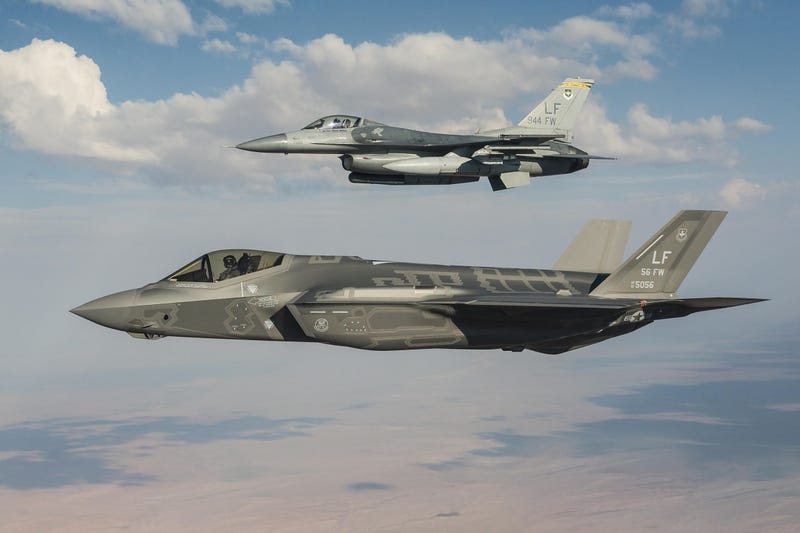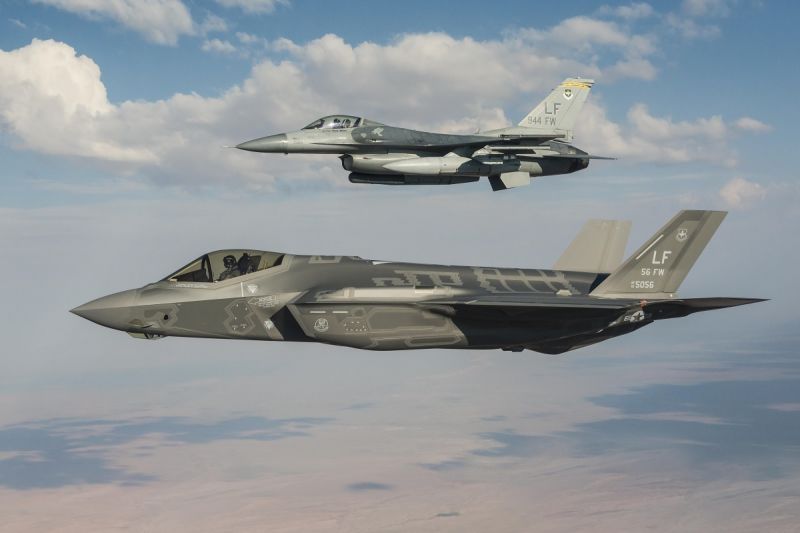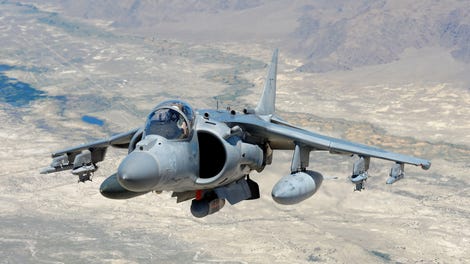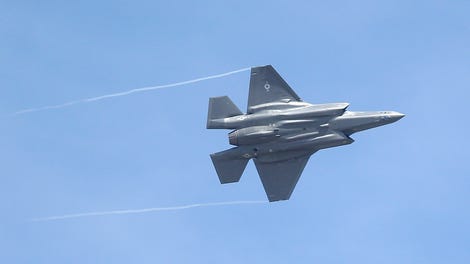
On Friday, the U.S. Air Force cancelled all F-35A Lightning II training flights at Luke Air Force Base just outside Phoenix, Arizona after it was reported five pilots had been experiencing hypoxia-like symptoms since May 2. The one-day pause at the base was to further examine the cause and further educate F-35 pilots on the effects of hypoxia. Officials originally stopped short of calling the suspension of flying operations a “grounding” and fully anticipated returning the jets to flying today, but that has not been the case.
The Air Force issued another statement late Monday morning extending the halt in flight operations at the base. It’s another unfortunate development for the perpetually troubled F-35 program, yet hypoxia is a prevalent and dangerous problem among modern aircraft that’s hardly limited to that jet or even the Air Force.
The 56th Fighter Wing at Luke AFB is the largest operator of the F-35 and is the central training hub for not only the Air Force but partner nations participating in the F-35A program. Approximately 55 F-35s are currently based at Luke with plans to bring the number to 144.
Advertisement
Yet F-35s at other bases are not affected by the issues at Luke and have continued normal flight operations. According to one report, the incidents occurred with five different jets from different squadrons and were not from the same production batches. It was not reported if only Air Force pilots experienced the symptoms or F-35 pilots from partner nations were among the five pilots who reported the problems. Apparently the backup oxygen system worked as expected in each case.
The statement said:
“The 56th Fighter Wing will continue their pause in local F-35A flying to coordinate analysis and communication between pilots, maintainers, medical professionals and a team of military and industry experts. This coordination will include technical analysis of the physiological incidents to date and discussions on possible risk mitigation options to enable a return to flying operations.
Updates will be provided as our teams work together toward safely returning to building the future of airpower through trained F-35A pilots. The safety of our Airmen is paramount and we will take as much time as necessary to ensure their safety.”
Hypoxia is the lack of oxygen in the body tissues, and while incidents of hypoxia have been reported below 10,000 feet the greatest risk occurs above that. The effects of hypoxia can often appear unnoticed at first, especially to those who are unfamiliar with the dangers and symptoms of hypoxia and will quickly manifest into larger problems.
Sponsored
On the ground humans breathe air with a 21 percent oxygen concentration to ensure the bloodstream is oxygenated sufficiently to stay alive. As altitude increases and air pressure decreases it becomes more difficult to take in the required oxygen increasing the likelihood hypoxia will occur.
Modern fighter aircraft typically operate with either of two oxygen systems to allow aircrew to breath at altitudes above 10,000 feet. Get ready for acronym time: these are called liquid oxygen (LOX) or on-board oxygen generation systems (OBOGS.) LOX provides 100 percent pure oxygen from a refillable tank in the aircraft while OBOGS allows an aircraft to generate its own oxygen during flight by cooling engine bleed air that is then passed through the OBOGS system and on to the pilots.
When I was put through the Air Force’s Altitude Chamber training several years ago, the experience in the class and eventually inside the hypobaric chamber made it readily apparent to me what hypoxia can do the human body and how quickly it can happen.
Conditions that can result include fatigue, confusion, the inability to concentrate (I remember trying to do single-digit addition with not enough oxygen at altitude and couldn’t complete the task), loss of consciousness and potentially death.
Advertisement
The video below is a great example of controlled hypoxia in a hypobaric chamber:
This is not the Air Force’s first experience with a stealth fighter causing hypoxia. In 2011 the F-22A Raptor was grounded for nearly five months after several pilots were affected by hypoxia during flight, including one who scraped the belly of his Raptor across trees as he was landing—and had to be told it happened after he landed. While the issue of hypoxia was first documented in the Raptor fleet in 2008 it was not until a fatal crash in late 2010 that forced the Air Force to fully address the growing problem, but even then only reluctantly as the service sought to protect its $67 billion fighter program.
On November 16, 2010, Air Force Capt. Jeff Haney was returning to Elmendorf Air Force Base near Anchorage when the F-22 he was piloting crashed, killing him instantly. The original crash report squarely laid the cause of the crash on the pilot despite admitting that the oxygen system on the plane malfunctioned causing Capt. Haney to experience what the report states was “severe restrictive breathing.” In essence, the Raptor was suffocating him.
Advertisement
As Haney tried to engage his backup oxygen supply the Raptor hit the Alaskan wilderness at a speed above Mach 1 which would send debris as far as a quarter-mile from the impact point.
The report casually called Haney’s focus on trying to engage his backup oxygen supply “channelized” forcing him to divert his attention from his primary mission: flying the jet. The report reads:
Advertisement
“During the mishap sortie, the mishap pilot most likely experienced a sense similar to suffocation when airflow to the oxygen mask stopped. This was likely the mishap pilot’s first experience under such physiological duress. The unique and added stress of the breathing restriction contributed to the mishap pilot’s channelized attention….By clear and convincing evidence…the cause of the mishap was the mishap pilot’s failure to recognize and initiate a timely dive recovery due to channelized attention, breakdown of visual scan and unrecognized spatial disorientation.”
Making the issue more complicated, the Pentagon’s Inspector General got involved in the accident review and determined the Air Force’s conclusion simply was “not supported by the facts.” As a result, the widow of Capt. Haney filed a lawsuit against the major contractors Lockheed Martin, Boeing, Honeywell and Pratt & Whitney in 2012 shortly after the Air Force released its highly flawed crash report. In August 2013, the contractors agreed to settle the lawsuit with a confidential agreement.
Advertisement
There was no “smoking gun” as far as what caused the hypoxia symptoms in the Raptor but part of the blame was attributed to a flaw in the pilots’ life support vest.
Designed to inflate during high-G flight to help pilots keep the blood flowing the vest to an occasional glitch would inflate when it was not needed and would cause symptoms similar to hypoxia. The vest was changed and ultimately an automatic backup oxygen system was installed on the Raptor.
Also, the Air Force does not have a monopoly on aircraft that have had recent troubles with pilots and hypoxia. In April, U.S. Navy instructor pilots refused to fly the T-45 training jet after a rapid increase in the number of oxygen deficient events during training flights. A 12-day safety stand down occurred and flight restrictions were imposed but a report this week indicates the Navy is still struggling with its T-45 issues and those problems are seriously hurting its training pipeline.
Advertisement
Even the Navy’s F/A-18 Hornet is not immune from problems of its aircrews suffering hypoxia-like symptoms during flight. The problem has become so great that the Navy has placed hyperbaric chambers on two deployed aircraft carriers to counter the effects of hypoxia for aviators returning to the ship. Both Legacy (A through D models) and Super Hornets airframes are experiencing near the same rate of incidents despite the older Legacy jets using LOX and the Super Hornets being equipped with OBOBGS.
There is no arguing that the threat of hypoxia is real to military fighter pilots and there seems to be no absolute cause—or causes—as to why. The oldest and newest fighters are showing symptoms regardless of the system providing the oxygen. This problem must be a priority and not swept under the rug like it has been in the past.
Advertisement
The Air Force has had enough issues getting its F-35s to full combat capability; the last thing it needs is to be forced to keep the jets on the ground because its pilots can’t breathe.


















